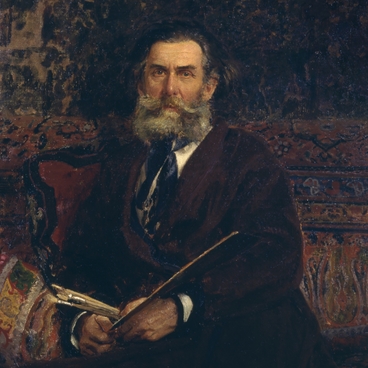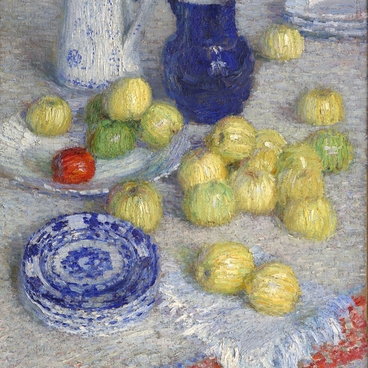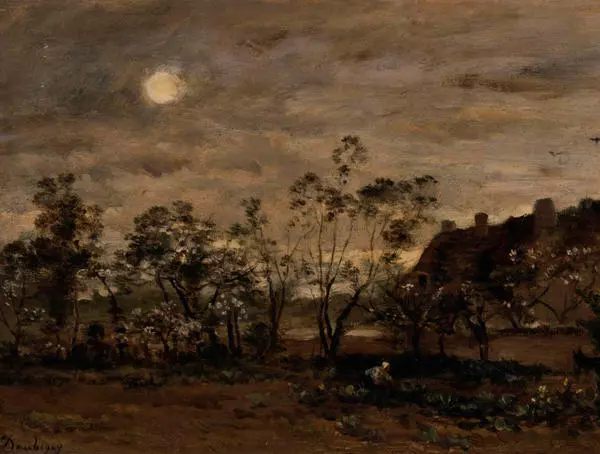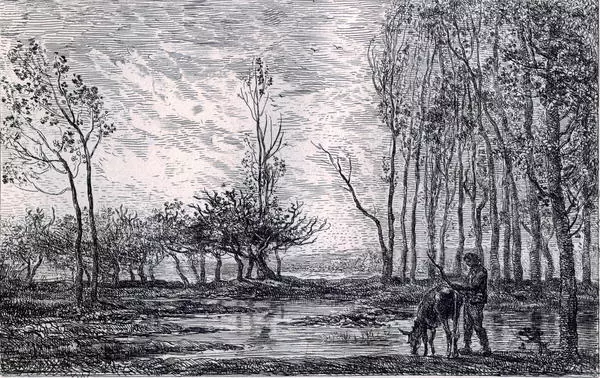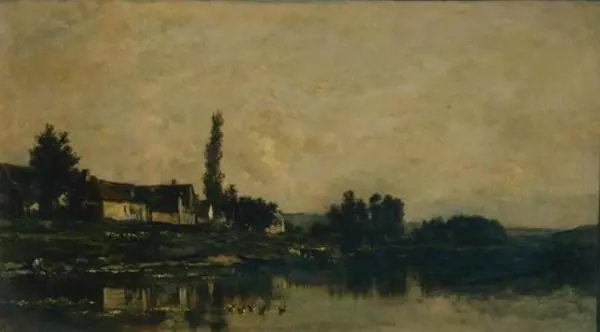French painter Charles Daubigny produced this sketch in 1865 from nature. In his life, he created a great number of landscapes, and almost all of them he devoted to his native France.
His simple lyric images of nature became a precursor for impressionism, which was a new movement in painting. One of its representatives Claude Monet wrote, Daubigny, he is a fine fellow, who works well and understands the nature.
Daubigny considered that it was necessary to picture the world around in a precise and truthful manner. This is why he used to work in the open air quite often and fixated even the smallest changes of the nature. For this purpose, he even equipped a floating studio on his boat Botin.
During one of voyages the created the Townlet on the Seine picture. He devotes it to his favourite theme – rural scenery. In the picture, there is a peaceful riverbank at sunset. The sun has already set beyond the horizon, but the sky is still shining and reflecting in the river water. A silhouette of a cathedral is blackening on the horizon.
The colour palette of the painting consists of dark paints. Shades of grey and pink colours prevail in the painting. He paints in transparent and light strokes, and uses barely perceptible iridescences of tones. In such a way he revives nature and creates perception of momentariness, uniqueness of moment, as if it would get absolutely dark in a few minutes, and the world around would change.
Daubigny inherited his profession as he was born in the family of a miniature painter. At the age of 17, the painter went to Italy, Holland, England and Spain to learn painting from local masters.
The diversity of European art, which he witnessed during his trips, influenced his manner of painting. In Paris Daubigny spent a lot of time in the Louvre where he was copying the works of art of Dutch masters in order to adopt their technique.
The painter belonged to the Barbizon School. It was a group of landscape painters, which appeared in France in 1830s. They used to paint realistic landscapes of their native country, and quite often depicted ordinary workers in them.
Daubigny was on friendly terms with painter Alexey Bogolyubov, and frequented his studio in Paris. During one of such visits, the painters exchanged sketches with each other. In 1885 when Bogolyubov was creating the Radishchev Museum, he donated his own collection of paintings. Townlet on the Seine was one of the paintings in it.
His simple lyric images of nature became a precursor for impressionism, which was a new movement in painting. One of its representatives Claude Monet wrote, Daubigny, he is a fine fellow, who works well and understands the nature.
Daubigny considered that it was necessary to picture the world around in a precise and truthful manner. This is why he used to work in the open air quite often and fixated even the smallest changes of the nature. For this purpose, he even equipped a floating studio on his boat Botin.
During one of voyages the created the Townlet on the Seine picture. He devotes it to his favourite theme – rural scenery. In the picture, there is a peaceful riverbank at sunset. The sun has already set beyond the horizon, but the sky is still shining and reflecting in the river water. A silhouette of a cathedral is blackening on the horizon.
The colour palette of the painting consists of dark paints. Shades of grey and pink colours prevail in the painting. He paints in transparent and light strokes, and uses barely perceptible iridescences of tones. In such a way he revives nature and creates perception of momentariness, uniqueness of moment, as if it would get absolutely dark in a few minutes, and the world around would change.
Daubigny inherited his profession as he was born in the family of a miniature painter. At the age of 17, the painter went to Italy, Holland, England and Spain to learn painting from local masters.
The diversity of European art, which he witnessed during his trips, influenced his manner of painting. In Paris Daubigny spent a lot of time in the Louvre where he was copying the works of art of Dutch masters in order to adopt their technique.
The painter belonged to the Barbizon School. It was a group of landscape painters, which appeared in France in 1830s. They used to paint realistic landscapes of their native country, and quite often depicted ordinary workers in them.
Daubigny was on friendly terms with painter Alexey Bogolyubov, and frequented his studio in Paris. During one of such visits, the painters exchanged sketches with each other. In 1885 when Bogolyubov was creating the Radishchev Museum, he donated his own collection of paintings. Townlet on the Seine was one of the paintings in it.


